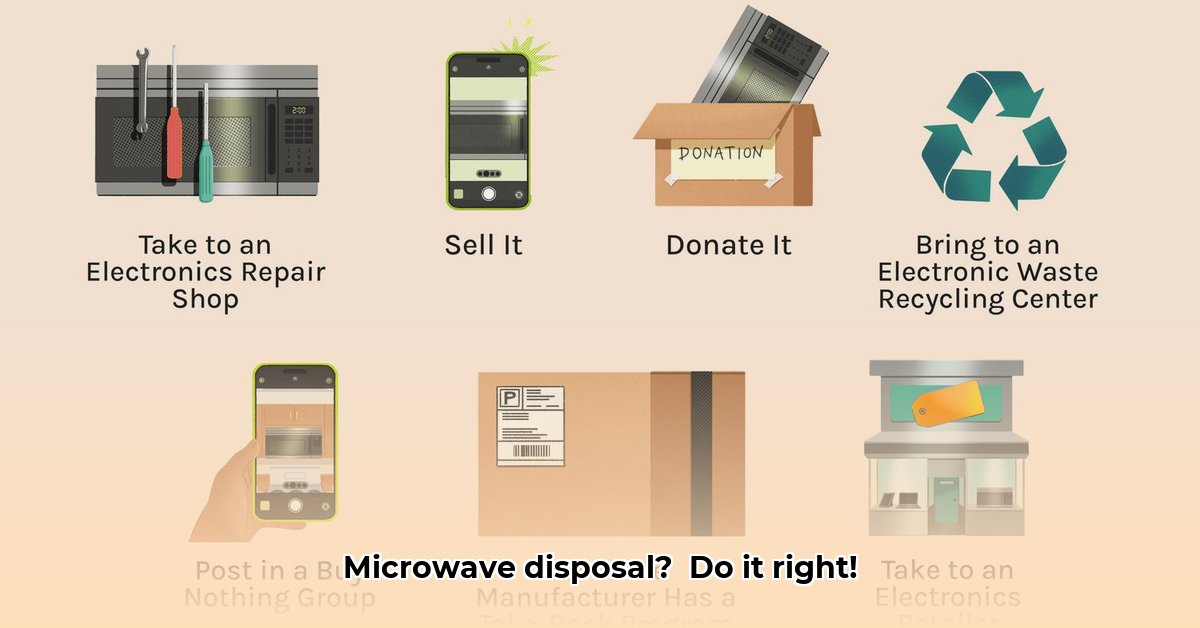Why Proper Disposal Matters
Improper microwave disposal poses several risks:
- Environmental Hazard: Microwaves contain hazardous materials like lead and mercury that can leach into landfills, contaminating soil and water sources. Responsible disposal prevents this environmental damage.
- Resource Depletion: Recycling microwaves recovers valuable metals, glass, and plastics, reducing the need to mine virgin resources. This conservation is crucial for a sustainable future.
- Legal Consequences: Many regions have strict regulations against discarding microwaves with regular trash. Proper disposal helps you avoid potential fines and legal complications.
Simple Steps for Eco-Friendly Disposal
- Assess Functionality: A working microwave can be donated or sold, extending its lifespan and benefiting others. Check its functionality before discarding.
- Consider Repair: A minor repair might be more cost-effective and environmentally friendly than buying new. Consult local repair shops or online tutorials.
- Research Local Rules: Your municipality likely has specific e-waste disposal guidelines. Check your local government’s website or contact your waste management department.
-
Choose Your Method: Several disposal options exist, including donation, resale, manufacturer take-back programs, e-waste recycling centers, and sometimes curbside pickup.
- Donation: Charities like Goodwill, the Salvation Army, and local shelters often accept working appliances. This is a great way to give back to your community.
- Resale: Online marketplaces like Craigslist, Facebook Marketplace, and eBay can connect you with buyers looking for used appliances. You might even make some money back!
- Manufacturer Take-Back Programs: Some appliance manufacturers offer recycling or take-back programs for their products. Check the manufacturer’s website or contact their customer service.
- E-waste Recycling Centers: These specialized centers safely dismantle and recycle electronics, ensuring hazardous materials are handled responsibly. Search online for “e-waste recycling near me” to find a local facility.
- Curbside Pickup: Some municipalities offer scheduled pickups for bulky items or e-waste. Consult your local waste management schedule for details.
-
Prepare for Disposal: Unplug the microwave, remove any loose parts like the turntable plate, and clean the interior to remove food debris. This makes it safer and easier for handling and processing.
- Transport Safely: Secure the microwave during transport to prevent damage or leaks. Follow any specific instructions provided by the chosen disposal facility or program.
Disposal Don’ts
- Never DIY Dismantling: Internal components can store high voltage even when unplugged, creating a risk of electric shock. Leave dismantling to trained professionals.
- Avoid Illegal Dumping: Improperly discarding a microwave can lead to environmental contamination and hefty fines. Choose legal and responsible options.
- Skip the Regular Trash: Microwaves don’t belong in your regular trash bin. This is harmful to the environment and likely against local regulations.
The Bigger Picture: E-waste Responsibility
By choosing responsible disposal, you contribute to a healthier planet and help conserve valuable resources. Promote e-waste awareness in your community and encourage others to do the same.
Latest posts by Yaride Tsuga (see all)
- Call of Duty Wont Launch on Steam? How to Fix It - January 3, 2026
- Why Is CoD Not Opening on Steam? Resolve Your Launch Issues - January 2, 2026
- Cod Not Loading Into Game? Try These Fixes - January 1, 2026
